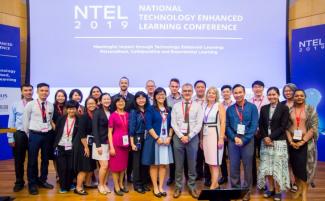
On 20 and 21 November 2019, Singapore Management University (SMU) hosted the third National Technology Enhanced Learning (NTEL) Conference at the SMU Mochtar Riady Auditorium for 300 faculty members and educators from the local universities and polytechnics.
This Conference was first held in 2015 and is co-organised by the local universities, with the aim to inspire teaching and learning transformation through the adoption of technology-enhanced learning strategies in higher education.
Themed “Meaningful Impact through Technology Enhanced Learning: Personalised, Collaborative and Experiential Learning”, the two-day conference featured three keynote speakers, various panellists and industry experts who shared their insights on how we can continue to make meaningful impact in the changing educational landscape.
Welcome Address by Professor Lily Kong, SMU President
In her welcome address, President of SMU, Professor Lily Kong shared that SMU’s Blue Ribbon Commission for Undergraduate Education had undertaken the significant work of reviewing its undergraduate education in 2017 and had clarified its conception of students and how they learn. She said, “we recognise students as individuals, as social beings and as members of a larger community, and with that underpinning, articulated the importance of personalised learning, collaborative learning, and experiential learning, as consequential pedagogical approaches to valorise and develop. We took the position that technology should be used to enhance these forms of learning.”
She also shared SMU’s approach towards employing technology in learning and cited an example of how the SMU School of Information Systems was using technology – a Competency Analytics Systems (CAS) developed by its own faculty – to support personalised learning. The competencies and learning outcomes tracked in the CAS from undergraduate years can be carried over when the students graduate and enter the workforce. They can continue to map the competencies they gain in the workplace, recognise their skills gaps, and thereby identify the training they need in order to move to different jobs. This will create continuity and integration between Pre-Employment Training and Continuing Education and Training.
Prof Kong then gave another concrete example which SMU had recently launched – the EdTech Greenhouse (EDGE), where identified Technology Enhanced Learning (TEL) projects undergo an incubation process and are then systematically translated to campus-wide IT solutions. Such projects are not within the means of any single unit to scale independently and would often require multidisciplinary skillsets to develop, implement, review, scale and support. Initiated by SMU’s Centre for Teaching Excellence (CTE), cross-functional teams across CTE, the Living Analytics Research Centre, Schools and our Integrated Information Technology Services department will bring together multi-disciplinary perspectives and skillsets to produce unique and better approaches to TEL that can significantly impact the quality of learning.
She added that at SMU, “impact in education is about delivering a holistic and transformative learning experience which then enables our students and graduates to make their own meaningful impact on the world. Impact is also about addressing societal challenges through research, which produces knowledge, insights and methods that contribute to improving our world and drive further learning.”
Opening Address by Guest of Honour, Ms Lai Wei Lin, 2nd Permanent Secretary (Education), Ministry of Education (MOE)
Ms Lai Wei Lin, 2nd Permanent Secretary (Education) MOE, said that technology has had a profound impact on learning and created possibilities in teaching and learning that we could never have imagined decades ago. For one, technology has greatly expanded access to a vast array of information and education resources so we are no longer limited to hard copy textbooks, and an extensive amount of information is now readily available at our fingertips through the internet. No longer limited to schools and classrooms, lessons are now available on online platforms.
In the face of this, Institutes of Higher Learning (IHLs) are also capitalising on technology to better support students’ learning, to make it more convenient for them to access learning and also to improve pedagogy and efficacy. She cited the example of NTU targeting to develop 1,500 courses to be hosted on the online space, to support NTU’s flipped classroom model where students can access course materials ahead of lessons. This results in a more productive use of in-class time for discussions and application of theory instead of just theory itself.
She added that “technology has also transformed the role of teachers and students. No longer the primary source of information, teachers need to evolve from “the sage on the stage, to a guide on the side”. Thus, we can and need to empower students to be more self-directed in learning while teachers invest their effort in designing suitable instructional activities to complement and enhance student learning.”
“While technology has opened up a vast world of opportunities in education, we should remember that the goal of any educational innovation is to create meaningful impact on students’ learning outcomes. Innovation for innovation’s sake has little impact if not fundamentally undergirded by data driven research and sound principles of the science behind learning. For instance, the migration of existing degree programmes online is not innovative in and of itself. While it gives access to instructional materials anytime and anywhere, we also need to ask ourselves how such an approach can enhance a student’s learning in terms of his or her learning efficacy”.
She added that “research has shown that social interaction among students coupled with an instructor presence have a strong, positive influence on students’ learning experience as the social environment of learning raises their satisfaction, motivation and retention of learning. As such, we need to carefully integrate the use of technology into teaching so as to yield that outcome. We must not lose sight of the chief aim of promoting a meaningful learning experience for students. Thus, we should be intentional in applying technology and try to strike an optimal balance between technology-mediated and human-delivered education. The key to knowing what this balance looks like is to study and measure the impact of various models of “blended” approaches to learning; we need to take a sound research approach and derive data-driven conclusions that can better inform effective application.”
Keynote by Professor Linda Price, Director of Academic and Organisational Development, University of Bedfordshire on “Digital futures? How should higher education prepare?”
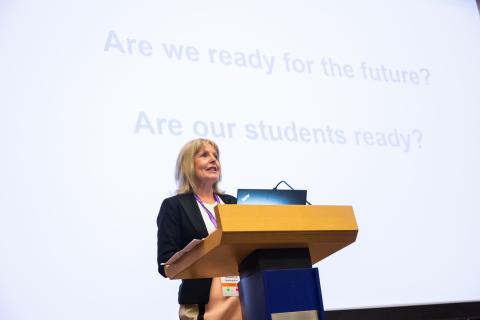
Professor Linda Price, Director of Academic and Organisational Development at the University of Bedfordshire spoke on how IHLs should prepare for the digital future.
She shared that despite considerable research into the use of technology in higher education, there is still a gap between what teachers might perceive as valuable digital curriculum design and what students perceive as valuable digital learning experiences. Thus, we need to understand how students engage with digital learning, so that we may forge pedagogically-led educational technology.
Frequently, TEL interventions appear to be technology-led, rather than responding to identified teaching and learning needs. While the TEL research may add to the body of literature, impact on improvements in practice are more difficult to ascertain. Those researching education technology would argue that they do provide evidence of the benefits of educational technologies, while those engaged in the scholarship of teaching and learning (SoTL) would counter this, arguing that TEL researchers are too distanced from practice. Hence research and practice would appear to be progressing along parallel, but largely independent tracks. If we are to bridge the gap between research and practice, and to produce sensible and actionable innovations, we need to adopt a SoTL approach to digital technologies.
In summary, she said that in order to prepare our students for the future, we needed to think about four key components: (i) designing learning that enables students to develop key skills for the future; (ii) challenge conventional thinking about “how” to create learning environments fit for the future; (iii) adopt a SoTL approach and incorporate relevant research so we are focused on real and tangible changes to teaching and learning; and (iv) provide staff development focused on effective teaching and learning.
Watch her video here.
Dr Sergio Hernandez-Marin, Business Analyst Lead, Google Pay, Google Singapore on “The potential of Artificial Intelligence in Personalised Learning”
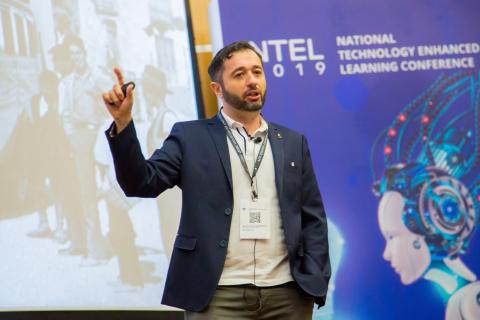
Dr Sergio Hernández-Marín, said the recent acceleration of innovation in Artificial Intelligence (AI) has been increasingly seen as a high potential tool to help in education. It offers the opportunity to enhance learning environments for the educator to better evaluate the learning process, as well as to help learners improve their learning experiences. He believes that AI will have a significant influence on education at all levels and will impact both the way we deliver education as well as the way students learn; getting deeper knowledge on subjects of interest, and improving professional skills.
He described a variety of ways in which AI is being used in personalised learning as well as future trends. These include the use of Machine Learning, where computers can detect patterns that humans cannot. He said that the education industry is already using chatbots, automated writing feedback, adaptive learning and personalised content. He then cited several initiatives by Google used for educational purposes and these included Socratic – a camera based learning application to get answers; AI Tutors – especially useful in remote India where little education opportunities exist; Expeditions – virtual reality at your hands where it allows students to “travel” far away and Kaggle – a gamification, collaborative learning platform.
But when asked how we could possibly incorporate moral education and emotions in AI, his response was that we still needed to rely on educators in the emotion aspect and that AI was just an enabler to learning.
Keynote by Professor Timothy McKay, University of Michigan on Personalising Education at Scale - Designing for Equity, Inclusion, and Student Success
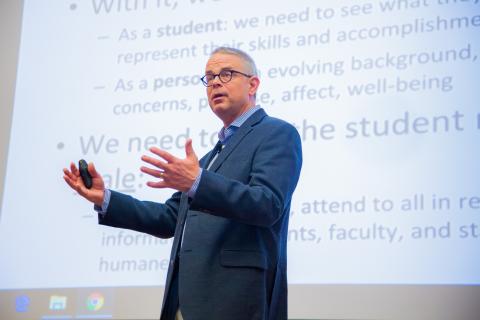
In his keynote, Professor Timothy McKay spoke on personalised learning and analytics and the different ways in which data and information technology may be used to support the various facets of a student’s university life. He touched on four ways to use data in order to do this and this included how data could be used for decision support. For example, at the University of Michigan, students can use the Atlas tool to select their desired modules/courses and using this platform enables them to make decisions and choices based on information and not impressions or anecdotes. He also cited the example of the SEISMIC project which involves collaboration across 10 American institutions where data is used to drive change.
For data and information technology to be used effectively to support equity, inclusion, and student success in large university settings, he asked that data be shared broadly – to inform decision-making by everyone involved in education; to remember that students are individuals and thus to treat their reduction to datafied representations with critical care; to use data one has to probe equity and to do so in collaboration with others; and finally to work together as educational institutions and use data to drive change.
Watch his video here.
Keynote by Professor Neil Selwyn, Faculty of Education, Monash University on “Meaningful impact through Technology Enhanced Learning … from state-of-the-art to state-of-the-actual”
In his keynote, Professor Neil Selwyn touched on the three levels of analysis that underpin this conference – student as an individual, student as a social being, and student as a member of the community. He examined how each of these levels corresponds to a range of broader contextual influences on how digital technologies are used (and not used) in education. The problem that we face, however, is that many ‘state-of-the-art’ discussions of educational technology pay little attention to these influences.
He argued that getting the best from digital technology requires educators and technologists to think carefully about these broader contexts of schools and universities, and how they can be worked with (and sometimes worked around). We needed to see TEL in sociotechnical terms – an ecosystem with many different layers and factors – politics, morals, ethics and culture.
He cautioned that we should not be too evangelical about technology but also talk about the limitations of technology, as there are some things that cannot be observed or measured, such as student experience in terms of emotions or mental health.
He concluded by suggesting that TEL can be successful when it is innate in the culture of the institution – trusting its people to use technology; when educators actively design the use of technology to support learning; and lastly, to demonstrate to students that technology is useful to support their learning.
Watch his video here.
Over both days, representatives from the six local universities hosted individual breakout session to share their perspectives and insights on topics. These include topics on “Transforming Higher Education Through Artificial Intelligence: Impact and Implications” facilitated by SMU, “Blended Learning: What’s Next? Creating Collaborative Learning Opportunities facilitated by Nanyang Technological University and “Defining Lifelong Learning from Different Perspectives” by Singapore University of Social Sciences.
In conjunction with the conference, there were MOE Tertiary Research Fund (MOE-TRF) projects and innovative technological research projects that were showcased by the various IHLs. The initiatives included SMU’s “Learning Analytics on Qualitative Student Feedback to Improve Teaching and Learning in Higher Education”, NTU’s “Leveraging Immersive Technologies for Flipped Learning: Impact on Engineering Students’ Situational Interest and Self-efficacy” and SIT’s “An Adaptive Online Learning Course for Mathematics and Physics”.
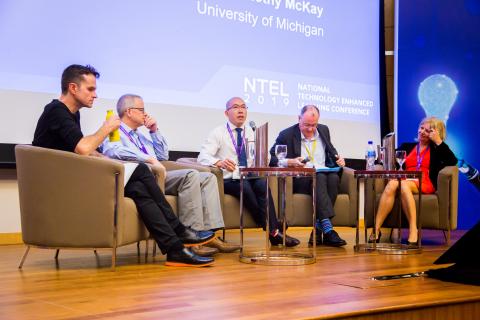
According to Chairman of the Organising Committee, Associate Professor Lieven Demeester, Director, Centre for Teaching Excellence at SMU, “One of the founding principles at SMU was that students are social beings, who learn well when they can participate in discussions and interact with one another. It is about students taking charge and receiving feedback. At the micro-level this means providing timely opportunities for students to test themselves. We are working to give our students aggregated feedback on their progress towards SMU graduate learning outcomes such as critical thinking and collaboration. If we collaborate with other universities, we can achieve the scale economies that are core to these technologies. I believe this conference has provided that collaborative platform for all IHLs to learn from each other and for us to leverage on technology to make our curriculum and pedagogy richer and broader.”
[Featured photo: Speakers and the organising team of the NTEL Conference 2019]